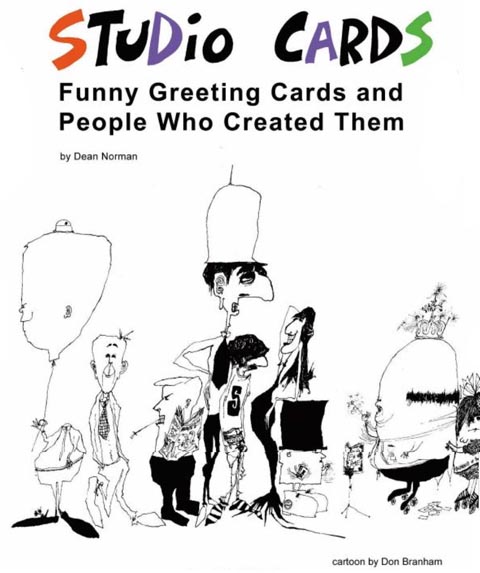

BOOK REVIEW: Studio Cards

One of my recent book purchases is Studio Cards: Funny Greeting Cards and People Who Created Them (2004). I needed the book for research purposes, and didn’t have any expectations beyond that, but once I started reading it, it was hard to put down.
The writer, Dean Norman, spent most of his career making “studio cards,” which is the name ascribed to a particular type of tall and funny greeting card that was popular from the Fifties through the Eighties. Dean worked both in Hallmark’s Contemporary department and American Greetings’ Hi-Brows, which were the “studio card” divisions of these two major greeting card companies. (He also worked in animation briefly at studios like DePatie-Freleng and Filmation.)
Hallmark was based in Kansas City and American Greetings was in Cleveland–these were traditional midwestern companies that didn’t try to challenge middle American values as media companies on the coasts did. They were happy to put out products that served a simple and honest purpose, and get rich ten to fifteen cents at a time. As a result, the greeting card industry had little glamour (even less than animation) and few of the artists believed they were making anything more than functional commercial art. Within those boundaries though, they created some funny and memorable work.
Some of the writers and artists discussed in the book will be undoubtedly familiar names–Robert Crumb, Tom Wilson of Ziggy and MAD‘s Paul Coker, Jr.–while others are anonymous talents like Don Branham, Larry Raybourne, John Gibbons, Bob Harr, Teresa Satow, and Jimmie Fitzgerald, the latter two artists being women.
The book compares favorably to Jack Kinney’s Walt Disney and Assorted Other Characters by managing to give the reader a sense of a time and place by focusing on individual artists. Norman’s stories (and he has a lot of them) made me smile and chuckle throughout, and by the end of the book, one walks away with a good sense of what it was like to work in the trenches of the greeting card biz.
Animation artists will be able to commiserate with many of Norman’s stories, especially when he discusses editors and art directors: “A good editor or good art director is perhaps the most rare creature on this planet,” he writes. “But companies large and small have these positions to fill, and the people who fill them do great damage to creativity. Often the position of editor or art director is a reward that is offered to a good writer or a good artist…If you are good, you can stop writing or drawing and become a manager who harasses other writers and artists.” Norman tells maddening stories about management’s constant search for formulas, like how when a series of cards with short characters starting selling well, Hallmark art directors demanded every artist draw only squat characters.
The book is illustrated with lots of greeting card examples and other ephemera that Norman collected over the years. It’s print-on-demand, so sadly it’s in black-and-white and the image quality is far from perfect. Also, as with most self-published projects, the book could have really used an editor to tighten up passages and help smooth out a lot of the chronological leapfrog. Having said that, I unequivocally recommend the book. It’s a valuable piece of history about a woefully neglected and undocumented area of commercial illustration and cartooning. Norman’s writing is heartfelt and his stories are delightful. If anything, this book helped convince me that Hallmark and American Greetings are sitting on some great archival material and that they should consider releasing compilations of all the funny cards they created.
